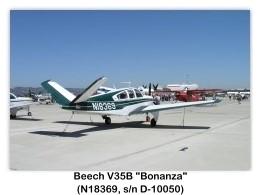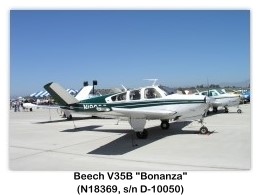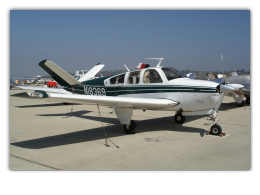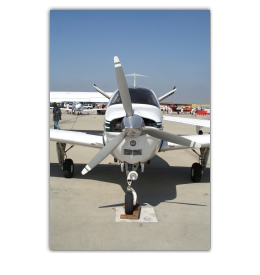

























Beechcraft V35B Bonanza
United States — Single-engine four/five-seat cabin monoplane
Archive Photos
Beech Bonanza Model V35B (N18369) at the 2006 Camarillo Air Show, Camarillo, CA




Overview
The Beechcraft Bonanza is an American general aviation aircraft introduced in 1947 by The Beech Aircraft Corporation of Wichita, Kansas. As of 2009 it is still being produced in derivative form by Hawker Beechcraft, becoming the longest-running production airplane in history. More than 17,000 Bonanzas of all variants have been built.
- Role: Civil utility aircraft
- Manufacturer: Beechcraft
- Designed by: Ralph Harmon (lead engineer)
- First flight: 22 December 1945
- Introduced: 1947
- Status: Active service
- Produced: 1947-present
- Number built: 17,000+
- Unit cost: approx. US$700,000 (2006)
- Variants: Beechcraft Baron, Bay Super V Bonanza
Design and Development
At the end of World War II two all-metal aircraft emerged, the Model 35 Bonanza and the Cessna 195, that represented very different approaches to the premium-end of the postwar civil aviation market. With its high wing, seven-cylinder radial engine, fixed tailwheel undercarriage and roll-down side windows, the Cessna 195 was little more than a continuation of prewar technology; the 35 Bonanza, however, was more like the fighters developed during the war, featuring an easier-to-manage horizontally-opposed six cylinder engine, a rakishly streamlined shape, retractable nosewheel undercarriage (although the nosewheel initially was non-steerable, or castering) and low-wing configuration.
Designed by a team led by Ralph Harmon, the model 35 Bonanza was the first truly modern high-performance personal aircraft It was a very fast, low-wing monoplane at a time when most light aircraft were still made of wood and fabric. The Model 35 featured retractable landing gear and its signature V-tail (equipped with a combination elevator-rudder called a ruddervator), which made it both efficient and the most distinctive private aircraft in the sky. The prototype 35 Bonanza made its first flight on 22 December 1945, with the first production aircraft debuting as 1947 models. The first 30-40 Bonanzas produced had fabric-covered flaps and ailerons, after which those surfaces were covered with magnesium alloy sheet.
A series of fatal accidents caused many to suspect flaws in the V-tail structural design. A study by Beech concluded that the cause was primarily use of the Bonanza for long-distance travel in all types of weather, and that the inflight breakups were mainly the result of excursions into extreme turbulence (as might be found in thunderstorms), not any inherent flaw in the design. Other types, such as the Cessna 210, that were similarly employed did not have the same breakup rate as the Bonanza, and a more likely explanation was that the leading edges of the stabilizers were cantilevered too far ahead of the main spars. FAA issued two Airworthiness Directives covering the V-tail. The first (AD 2002-21-13) applied only to the earliest 35, A35, and B35 models built in 1947 to 1950, and mandated a detailed inspection and repair procedure. The second (AD 94-20-04 R2) required a one-time inspection of the empennage structure, reinforced the need for correct balancing of the control surfaces and tensioning of the cables, and included the installation of a cuff securing the leading edge of the stabilizers to the fuselage skins.
In 1982 the V-tail Bonanza was dropped from production, though more than 6,000 V-tail models are still flying today. In general aviation circles, the epithet "fork-tailed doctor killer" became a familiar denigration of the V-tail model. Many V-tailed Model 35 Bonanzas are still flying, and they command a premium price on the used aircraft market.
The conventional-tail Model 33 continued in production until 1995. Still built today is the Model 36 Bonanza, a longer-bodied, straight-tail variant of the original design, introduced in 1968.
All Bonanzas share an unusual feature: the yoke and rudder pedals are interconnected by a system of flexible bungees which assist in keeping the airplane in coordinated flight during turns. The bungee system allows the pilot to make coordinated turns using the yoke alone, or with minimal rudder input, during cruise flight. On takeoff increased right-rudder pressure is still required to overcome torque and P-factor. In the landing phase the bungee system must be over-ridden by the pilot when making crosswind landings and cross-controlled inputs are required to keep the nose of the airplane aligned with the runway centerline without drifting left or right. This feature started with the V-tail and persists on the current production model.
The Twin-engine variant of the Bonanza is called the Baron, whereas the Twin Bonanza is a different design and not based on the original single-engine Bonanza fuselage.
QU-22 Pave Eagle
The QU-22 was a Beech 36/A36 Bonanza modified during the Vietnam War to be an electronic monitoring signal relay aircraft, developed under the project name "Pave Eagle" for the United States Air Force. A reduction geared Continental IO-520 engine was used to reduce its noise signature, much like the later Army-Lockheed YO-3A. These aircraft were intended to be used as unmanned drones to monitor sensors along the Ho Chi Minh Trail in Laos and report troop and supply movements. However when the project was put into operation in 1968, the drones were all flown by pilots of the 554th Reconnaissance Squadron.
Six YQU-22A prototypes (modifications of the Beech 33 Debonair) were combat-tested in 1968 and two lost during operations, with a civilian test pilot killed. 27 QU-22Bs were modified, 13 in 1969 and 14 in 1970, with 6 lost in combat. Two Air Force pilots were killed in action. All of the losses were due to engine failures or effects of turbulence.
Variants
Model 33 Debonair/Bonanza (BE33)
- 35-33 Debonair: (1959) An M35 Bonanza with conventional fin and tailplane, one 225 hp Continental IO-470-J, 233 built.
- 35-A33 Debonair: (1961) Model 33 with rear side windows and improved interior trim, 154 built.
- 35-B33 Debonair: (1962-1964) A33 with contoured fin leading edge, N35 fuel tank modifications and P35 instrument panel, 426 built.
- 35-C33 Debonair: (1965-1967) B33 with teardrop rear side windows, enlarged fin fairing and improved seats, 305 built.
- 35-C33A Debonair: (1966-1967) C33 with a 285 hp Continental IO-520-B engine and optional fifth seat, 179 built.
- D33 Debonair: One S35 modified as a military close-support prototype.
- E33 Bonanza: (1968-1969) C33 with improved Bonanza trim, 116 built.
- b>E33A Bonanza: (1968) E33 with a 285 hp Continental IO-520-B engine, 85 built.
- E33B Bonanza: E33 with strengthened airframe and certified for aerobatics.
- E33C Bonanza: (1968-1969) E33B with a 285 hp Continental IO-520-B engine, 25 built.
- F33 Bonanza: (1970) E33 with deeper rear side windows and minor improvements, 20 built.
- F33A Bonanza: (1970-1994) F33 with a 285 hp Continental IO-520-B engine, later aircraft have a longer S35/V35 cabin and extra seats, 821 built.
- F33C Bonanza: (1970) F33A certified for aerobatics, 118 built.
- G33 Bonanza: (1972-1980) F33 with a 260 hp Continental IO-470-N engine and V35B trim, 50 built.
Model 35 Bonanza (BE35)
- 35: (1947-1948), main production with 165 hp (123 kW) Continental E-185-1 engine, 1500 built.
- A35: (1949) Model 35 with higher take-off weight, and minor internal changes, 701 built.
- B35: (1950) A35 with a 165 hp Continental E-185-8 engine and other minor changes, 480 built.
- C35: (1951-1952) B35 with a 185 hp Continental E-185-11 engine, metal propeller, larger tail surfaces and higher take-off weight, 719 built.
- D35: (1953) C35 with increased Take-off weight and minor changes, 298 built.
- E35: (1954) D35 with optional E-225-8 engine and minor changes, 301 built.
- F35: (1955) E35 with extra rear window each side, 392 built.
- G35: (1956) F35 with a Continental E-225-8 engine, 476 built.
- H35: (1957) G35 with a Continental O-470-G engine, strengthened structure and internal trim changes, 464 built.
- J35: (1958) H35 with a fuel injected Continental IO-470-C engine, optional autopilot and improved instruments, 396 built.
- K35: (1959) J35 with fuel load increase, optional fifth seat and increased take-off weight, 436 built.
- M35: (1960) K35 with cambered wing tips and minor changes, 400 built.
- N35: (1961) M35 with a 260 hp Continental IO-470-N engine, increased fuel capacity, increased take-off weight and teardrop rear side windows, 280 built.
- O35: (1961) Experimental version, an N35 fitted with laminar flow airfoil and redesigned landing gear; only one built.
- P35: (1962-1963) N35 with new instrument panel and improved seating, 467 built.
- S35: (1964-1965) P35 with a Continental IO-520-B engine, higher take-off weight, longer cabin interior, optional fifth and sixth seat, 667 built.
- V35: (1966-1967) S35 with higher take-off weight single-piece windshield, optional turbocharged TSIO-520-D engine (as V35-TC), 873 built.
- V35A: (1968-1969) V35 with a streamlined windshield and minor changes, optional turbocharged TSIO-520-D engine (as V35A-TC), 470 built.
- V35B: (1970-1982) V35A with minor improvements to systems and trim, optional turbocharged TSIO-520-D engine (as V35B-TC), 873 built.
Model 36 Bonanza (BE36)
- 36: (1968-1969) E33A with a ten-inch fuselage stretch, four cabin windows each side, starboard rear double doors and seats for six, one 285 hp Continental IO-520-B engine, 184 built.
- A36: (1970-2005) Model 36 with improved deluxe interior, a new fuel system, higher take-off weight, from 1984 fitted with a Continental IO-550-BB engine and re-designed instrument panel and controls, 2128 built.
- A36TC: (1979-1981) Model 36 with a 3-bladed propeller and a 300 hp turbo-charged Continental TSIO-520-UB engine, 280 built.
- T36TC: (1979) A36 fitted with T-tail and a 325 hp Continental TSIO-520 engine, one-built.
- B36TC: (1982-2002) A36TC with longer span wing, increased range, re-designed instrument panel and controls, higher take-off weight, 116 built.
- G36: (2006-present) - Glass cockpit update of the A36 with the Garmin G1000 system.
QU-22
- YQU-22A (Model P.1079): USAF military designation for a prototype intelligence-gathering drone version of the Bonanza 36, six built.
- YAU-22A (Model PD.249): Prototype low-cost close-support version using Bonanza A36 fuselage and Baron B55 wings, one built.
- QU-22B: Production drone model for the USAF operation "Pave Eagle," 27 built.
Modifications
- Propjet Bonanza (A36): Standard aircraft modified by Tradewind Turbines with an Allison 250-B17F/2 turboprop engine (Original STC by Soloy).
- Turbine Air Bonanza: B36TC modified by West Pacific Air, LLC and Rocket Engineering with a Pratt & Whitney PT6A-21 turboprop engine.
- Whirlwind System II Turbonormalized Bonanza (36, A36, G36): Standard aircraft modified by Tornado Alley Turbo with a Tornado Alley Turbonormalizing System and approved for a 4000 lbs. MTOW.
- Whirlwind TCP Bonanza (A36TC or B36TC): Standard aircraft modified by Tornado Alley Turbo with a TCM IO-550B Engine and Tornado Alley Turbonormalizing system. This airframe is approved for a 4042 lbs. MTOW.
Unlicensed Version
- Parastu: This is the standard F33 (1970) variant of the Bonanza that Iran has reverse engineered and is manufacturing without a license.
Military Operators
- Argentina
- Bolivia
- Brazil
- Haiti
- Iran
- Israel
- Indonesia
- Ivory Coast
- Mexico
- Netherlands
- Nicaragua
- Spain
- Thailand
- United States
Specifications (1953 Model D35)
General Characteristics
- Crew: 1
- Capacity: 3 passengers
- Length: 25 ft 2 in (7.67 m)
- Wingspan:
- Height: 7 ft 7 in (2.31 m)
- Wing area: 178 ft² (16.5 m²)
- Empty weight: 1,675 lb (760 kg)
- Max takeoff weight: 2,725 lb (1,236 kg)
- Powerplant: 1 × Continental E-185-11, 205 hp (153 kW)
- Zero-lift drag coefficient: 0.0192
- Drag area: 3.48 ft² (0.32 m²)
- Aspect ratio: 6.20
Performance
- Maximum speed: 191 mph (166 kn, 306 km/h)
- Stall speed: 63 mph (55 kn, 101 km/h)
- Range: 779 mi (677 NM, 1,247 km)
- Rate of climb: 1,100 ft/min (5.6 m/s)
- Lift-to-drag ratio: 13.8
References
- Shupek, John. Photos via The Skytamer Archive, copyright © 2009 Skytamer Images. All Rights Reserved
- Wikipedia, the free encyclopedia. Beechcraft Bonanza































































